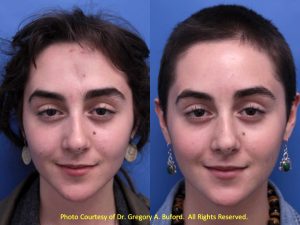Minimize Scars
Scars are an inevitable part of life. The formation of scar tissue is our body's way of healing, and there is really no way to guarantee perfect healing from any scar.
However, there are a number of treatments we can use to help modulate and direct surgical scar healing in a more positive manner, as well as options to help correct and minimize scars from trauma, acne, or medical treatments.
During his residency training, Lone Tree board-certified plastic surgeon Gregory A. Buford, MD, FACS, PCEO was exposed to a variety of approaches for scar optimization and noted that every patient seemed to heal a little differently.
As such, what worked for one person was not necessarily as effective for the next. Dr. Buford continues to adopt a personalized approach to scar care, and he has developed a suite of innovative scar remodeling techniques to help a variety of patient concerns.
Face & Skin Self-Assessment
Before you meet with Dr. Buford for your consultation, consider filling out our face and skin self-assessment. By sharing how you see yourself, we can best evaluate your aesthetic goals and determine an appropriate treatment plan for you.
Download the face & skin self-assessment form
Keep Your Surgical Results Beautiful
One of the biggest concerns most plastic surgery patients have is how their scars are ultimately going to heal. For some procedures, such as a breast augmentation, scars can be neatly tucked in an inconspicuous skinfold, while other procedures, such as a breast lift, require that scars be placed in a more noticeable location. For the most part, there are three main factors that determine how an incision ultimately heals:
- How well the incision was closed
- How well the tissue healed
- How well you heal in general
Dr. Buford has found that a combination of fractional CO2 laser resurfacing and topical steroid application is an effective method for reducing the appearance of post-surgical scarring.
Scar Remodeling Is Included in Our Plastic Surgery Care
Six months following surgery, Dr. Buford determines if a patient's scar will benefit from remodeling. If so, a series of three to four treatments are scheduled, spaced two months apart.
This is followed by at-home treatments of SkinMedica's TNS Recovery Complex, which should be applied to the scar twice daily for several months to help aid in the remodeling. Dr. Buford bundles the price of laser scar remodeling into each surgical procedure.
Reducing Scars With Subcision & Dermal Fillers
Skin conditions such as acne and certain medical treatments such as steroid injections can result in conspicuous indentations, as fibrous scar tissue draws the skin downward, creating a depressed scar.
Such scars typically require subcision, or a minimally invasive procedure that involves gently releasing the fibrous tissues beneath the skin. This allows the skin to revert into a more normal position.
Dr. Buford has found that pairing scar subcision with dermal filler injections such as Juvederm Ultra XC can achieve superior results to subcision alone for improving many types of depressed scars. After the fibrous tissue is released, Dr. Buford will inject filler at the site to immediately bring the scar area into alignment with the remaining skin.
This offers two main advantages over subcision alone:
- Instantly visible improvement while new collagen and elastin is produced in the area
- The filler provides a temporary scaffolding to help prevent fibrous tissue from re-forming an indentation
To see a real patient example of how Dr. Buford has helped individuals improve scars with subcision and dermal fillers, read this post on Dr. Buford's blog.
Remodeling Scars With Microneedling & Growth Factor
Smaller scars from injury, stretch marks, and acne scars can be significantly improved with Dr. Buford's state-of-the-art nonsurgical treatment that combines microneedling with an infusion of ProCell growth factor serum.
By making a series of tiny, undetectable punctures in the skin, microneedling stimulates collagen and elastin production to naturally repair skin cell damage. An infusion of ProCell MicroChannel Delivery Serum immerses the healing cells with natural growth factors and cytokines derived from stem cells to accelerate healing.
Does Scar Revision Hurt?
Denver Scar Revision With ProNox®
We use ProNox® to ensure your ultimate comfort during your in-office scar revision treatment. ProNox is an innovative pain management system that uses a 50/50 combination of nitrous oxide and oxygen to minimize discomfort.
Nitrous oxide is one of the oldest and safest forms of sedation; it calms the central nervous system to help make your procedure even more comfortable.
ProNox is patient-controlled, meaning that you simply breathe through the mouthpiece whenever you feel that you need it. The pain-reducing effects are immediate, and the gas will be completely out of your system within a few minutes, which allows you to return to your normal activities without lingering side effects.
Read more about how ProNox® can make your in-office procedures more comfortable >
Schedule Your Consultation
To learn more about scar remodeling options or to schedule your personal consultation, contact our Lone Tree plastic surgery center today!

